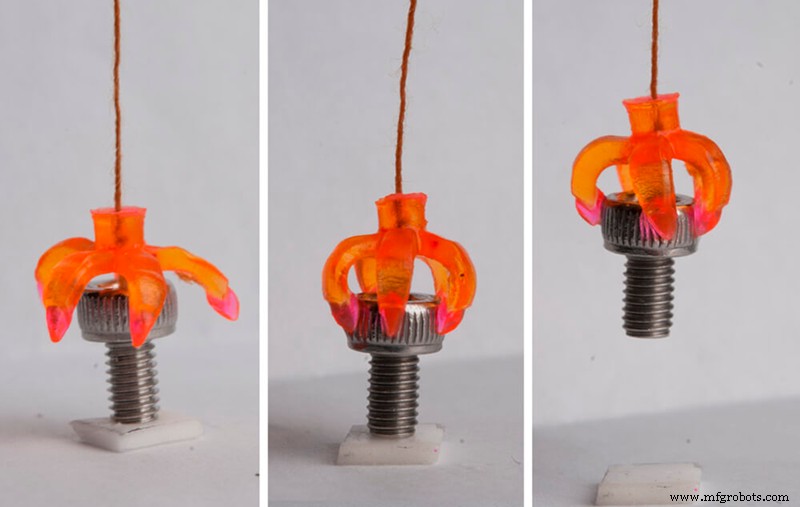4D プリント:3D プリントの未来
パイプが自動修復できたら ひびが入ったり壊れたりした場合、または天候やユーザーの活動に応じて衣服が変化する可能性がある場合 ?自分で組み立てる家具、成長に適応する人工装具...これらは、4D 印刷技術が実現すると想定されているアプリケーションのほんの一部です。

画像 1:形状を変更する 4D プリントされた爪。出典:スカルプテオ。
3D プリント はほぼ 30 年間存在しており、まだ研究の過程にあり、新しい材料や用途を発見し、4D などの新しい技術が出現しています。
MIT 自己組織化ラボで 、彼らは 4D 印刷が一部であるプロジェクトを開発しました。その目的は、テクノロジーとデザインを組み合わせてプログラム可能な材料を発明することです 構造、製造、製品の組み立て、および性能を再発明することを目的とした自己組織化技術。一方、ウィス研究所による研究 (ハーバード大学の一部)水と接触すると形状が変化する物体を印刷することに成功しました e、その端の一種の開花をもたらします。彼らは、印刷プロセス中にセルロース繊維を注入した、植物などの自然の構造に基づいた素材を開発しました。
ビデオ 1:シェイプ シフト アーキテクチャ。出典:ハーバード大学
4D プリントとは
自己組織化の原理に着想を得た4D プリントは、温度、光、その他の環境刺激などの外部エネルギー入力の影響により、3D プリントされたオブジェクトが別の構造に変換されるプロセスです。 つまり、3D テクノロジーを使用して、その素材の特性により、環境刺激を受けると変化するオブジェクトを取得することです。
これがまさに違いです 3D テクノロジーと 4D テクノロジーの間:人間の介入なしに時間の経過とともに変化するオブジェクトの能力。
使用素材
4D プリントの鍵はプロセスではなく 、おなじみの 3D プリンターに基づいていますが、素材は異なります。 これはかなり新しい技術であるため、利用可能な材料は、標準の 3D 印刷に使用されるものほど多様ではありません。ただし、非常に興味深いものもいくつかあります。
SMP (形状記憶ポリマー)
室温で剛性を保ち、ガラス転移点に達すると特別な特性を示すポリマー。例としては、Convena の TPU SMP があります:TPU に基づく組成の 4D フィラメント (熱可塑性ポリウレタン) を使用して、3D プリント パーツの形状を変更するための後処理を可能にします。 Thanks to its special composition and Shape Memory Polymer technology, parts printed with this filament can be modified manually, allowing them to acquire another shape and maintain it over time.
The process of modifying the shape of a 3D printed part with SMP TPU filament consists of placing the 3D printed part in a container of hot water until it reaches its glass transition temperature. At this point, the part softens and the user can easily modify its shape. Once cooled, the part maintains the acquired shape and remains stable. In addition, parts 3D printed with SMP TPU filament can be restored to their original shape by reversing the process. In other words, the material's glass transition temperature is reached again.
LCE (liquid crystal elastomers)
They contain liquid crystals that are sensitive to heat. By controlling their orientation, the desired shape can be programmed: under the effect of temperature, the material will relax and transform according to the dictated code.
Hydrogels
Polymer chains consisting mainly of water , particularly used in light-curing processes. The latter are focused on the medical sector due to their biocompatibility.
In addition, some 4D printing processes can use various materials, mainly composites such as wood or carbon, which are added to SMP or hydrogels. This results in objects with rigid and movable areas.
アプリケーション
Given the many advantages of such intelligent materials, the applications of 4D printing are innumerable.
Construction
The construction of climate-adapted structures such as bridges, shelters or other facilities would be a huge step forward in this field. 4D bricks capable of modifying walls and roofs to suit the environment would allow indoor conditions to be modified and improved.
Video 2:Programmable wood. Source:Self-Assembly Lab, MIT.
Medicine
In this case, 4D printing offers the possibility to create tailor-made, intelligent and evolving devices. For example, by 4D printing an implant, its condition and viability could be more easily monitored once it is integrated into the patient.
This concept is applicable to all regenerative medicine and the fabrication of cellular structures. 4D printing would allow cells to adapt to the human body depending on its temperature, 例えば。 If we talk about medicines, it would be possible, for example, to print a device that would release the required dose depending on the patient's body temperature.
Transport
A few months ago, BMW and MIT presented their inflatable material, which changes shape and size under the effect of air pulses. The applications are very interesting, as in the future we could have tyres that can repair themselves in case of a puncture or adapt to the terrain and weather conditions of the environment.
In the case of the aircraft industry, a 4D printed component could react to atmospheric pressure or temperature changes and thus change its function. Airbus is currently working on such developments, as these components could replace hinges and hydraulic actuators, significantly lightening the devices . In addition, it is also working on the development of heat-reactive materials to cool its aircraft engines.
Raúl Pulido Casillas, a Spanish engineer, has created a 4D-printed smart fabric for NASA. The metallic mesh, made of silver pieces joined together, has thermal regulation programmed into its print. In other words, not only its shape has been printed, but also the function of the materials. As it is able to reflect heat on the outside and retain it on the inside, it could be an ideal element for making astronaut suits or covering spacecraft.
Fashion
In the textile industry, 4D printing is also finding its place. The possibility of printing shoes that adapt to movement, impact, temperature and atmospheric pressure is a possibility. The US military has already made a foray into this field and is testing uniforms that change colour depending on the environment, or that regulate perspiration depending on the soldier's pulse or the ambient temperature.
Although we are still in its infancy, it is certain that 4D technology will revolutionise the manufacture and nature of objects over the next few years, just as 3D printing did in its day.
3Dプリント



